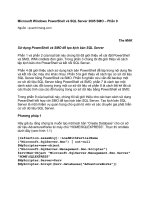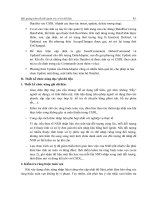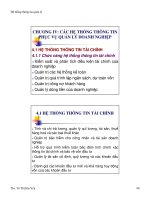Database Design Using Entity-Relationship Diagrams phần 9 pptx
Bạn đang xem bản rút gọn của tài liệu. Xem và tải ngay bản đầy đủ của tài liệu tại đây (253.77 KB, 33 trang )
Structural Constraints in the Barker/Oracle-Like
Model
In the Barker/Oracle-like notation, the cardinality of 1 is shown by a single
line leading up to the entity. In Figure 10.5
, a single line joins the two entities,
so this is a 1:1 relationship between STUDENT and AUTOMOBILE. This
means that one student can be related to one and only one automobile, and
one automobile can be related to one and only one student.
Figure 10.5:
1:1 Relationship in the Barker/Oracle-Like
Notation
The dashed line leading up to an entity signifies optional (partial)
participation of an entity in a relationship. In Figure 10.5
, both the STUDENT
entity and the AUTOMOBILE entity are participating optionally in the
relationship.
An enhanced grammar from the STUDENT entity to the AUTOMOBILE
entity would be:
A student may drive one and only one automobile
And for the AUTOMOBILE entity to the STUDENT entity would be:
An automobile must be driven by one and only one student.
A continuous (solid) line coming from an entity (as shown in Figure 10.6
)
signifies mandatory (full) participation of that entity in a relationship. So,
according to Figure 10.6
, students
must
occupy dorms, but a dorm
may
have students.
A cardinality of M (many) is shown by "crowsfoot" structure leading to the
respective entity. Figure 10.6
is an example of a 1:M relationship between
DORM and STUDENT. The exact grammar of Figure 10.6
would be:
A dorm may be occupied by zero or more students
or
A student must occupy one and only one dorm.
Figure 10.6:
1:M Relationship in the Barker/Oracle-Like
Notation
Checkpoint 10.2
1. How is the "optional" relationship shown diagrammatically in the
Barker/Oracle-like model?
2. How is the "many" relationship shown diagrammatically in the
Barker/Oracle-like model?
3. Show the following using the Barker/Oracle-like notation:
a. A movie theater must show many movies and movies must be
shown in a movie theater.
b. A movie theater may show many movies and movies may be
shown in a movie theater.
Dealing with the Concept of the Weak Entity in the
Barker/Oracle-Like Model
The Barker/Oracle models do not have a concept of the "weak entity," and
the weak entity notation is not used in Oracle literature either. We will extend
the concept of the unique identifier in a relationship to include the weak
entity. In the Barker/Oracle-like model, the unique identifier in a relationship
can be diagrammatically shown by a bar cutting across the contributing
relationship, as shown in Figure 10.7
. In Figure 10.7, to uniquely identify a
dependent, one needs the employee's social security number. This means
that the DEPENDENT entity cannot independently stand on its own, and
hence is a weak entity. However, here the weak entity would be mapped as
per the mapping rules discussed in Chapter 5
.
Figure 10.7:
Unique Identifier Shown by Placing Bar across Contributing
Relationship Line(s)
Dealing with the Concept of Multi-Valued Attributes
in the Barker/Oracle-Like Model
Again, although the Barker/Oracle models do not have the concept of the
"multi-valued" attribute, multi-valued attributes can be shown as in Figure
10.8.
Figure 10.8
shows that a student may have attended many schools. In the
Barker/Oracle-like model, the foreign key is shown in the appropriate entity,
whereas in the Chen-like model, foreign keys are not "discovered" until the
database is mapped. We will signal a foreign key with an asterisk (*) in front
of the attribute (see Figure 10.8
). An instance of this database shown in
Figure 10.8
is:
STUDENT
sname address
Sumona Gupta 111 Mirabelle Circle, Pensacola, FL
Tom Bundy 198 Palace Drive, Mobile, AL
Tony Jones 329 Becker Place, Mongotomery, AL
Sita Pal 987 Twin Lane, North Canton, OH
Neetu Singh 109 Bombay Blvd, Calicut, CA
SCHOOL
sname school
Sumona Gupta Ferry Pass Elementary
Sumona Gupta PCA
Sumona Gupta Pensacola High
Tom Bundy Mobile Middle School
Tom Bundy St. Johns
Tony Jones Montgomery Elementary
Tony Jones Montgomery Middle
Tony Jones Montgomery High
Sita Pal Tagore Primary School
Sita Pal Nehru Secondary School
Figure 10.8:
Unique Identifier Shown by Placing Bar across Contributing
Relationship Line(s) [
Note:
"*" shows a foreign key.]
As you can see, the multi-valued attribute is mapped to tables as it is
depicted in the Barker/Oracle-like notation. In the Chen-like model, the
multivalued attribute is kept in the diagram and then mapped using the
mapping rules (see mapping rule M1c).
Checkpoint 10.3
1. Does the Barker-like model or the Oracle-like model have the concept
of the "weak entity
"? Discuss.
2. Show the following using the Barker/Oracle-like notation: For a
student, we are trying to store the student's name, address, phone,
books (i.e., books that the student borrows from the library). Map this
to a relational database and show some sample data.
Treatment of Foreign Keys
In the original Barker model, foreign keys are not marked. In the Oracle
model, however, foreign keys are included in the respective relations. For
example, in Figure 10.9
, which says:
A student may drive many automobiles
and
An automobile must be driven a student.
The primary key from the STUDENT relation (the 1 side), student number, is
included in the AUTOMOBILE relation (the N side). In our Barker/Oracle-like
model, we will precede the foreign key with an "*" (as shown in Figure 10.9
).
Figure 10.9:
Barker/Oracle-Like Notation Showing Foreign
Key
Recursive Relationships in the Barker/Oracle-Like
Model
Recursive relationships in the Barker/Oracle-like model are drawn as shown
in Figure 10.10
. Once again, the dotted line in the relationship shows an
optional relationship, the solid line would show a mandatory relationship, and
a "crowsfoot" would show a "many" relationship. The relationships are
named as shown. Figure 10.10
shows that an employee may supervise
other employees and an employee may be supervised by one and only one
supervisor. Note the foreign key, super_ssn, in the EMPLOYEE relation
itself.
Figure 10.10:
Barker/Oracle-Like Notation: Recursive
Relationships
Mapping M:N Relationships
Finally, we discuss one last important aspect that is treated differently in the
Barker/Oracle-like model — an M:N relationship. In the Barker/Oracle-like
model, all M:N relationships are resolved into two 1:M relationships with an
intersection entity in the middle. In the Chen-like model, the M:N relationship
can also be presented as two 1:M relationships.
Take Figure 10.11
, for example (this is in the Chen-like format). In the
Barker/Oracle-like model, this would be shown as in Figure 10.12
.
Figure 10.11:
An ER Diagram of an M:N Relationship in the Chen-Like
Model
Figure 10.12:
Barker/Oracle-Like Notation: M:N Relationship Broken
into Two 1:M Relationships
Checkpoint 10.4
1. How are recursive relationships shown in the Barker/Oracle-like
model?
2. Why is it difficult to show M:N relationships in the Barker/Oracle-like
model?
3. How are the foreign keys treated in the Barker/Oracle-like model?
Chapter Summary
This chapter briefly discussed some of the main features of the
Barker/Oraclelike model. The "one-entity" diagram, with attributes, was
presented. The idea of optional versus mandatory attributes was discussed.
Relationships and structural constraints were briefly discussed in the context
of the Barker/Oracle-like model, and although the Barker/Oracle-like notation
does not use the concept of the weak entity and multi-valued attributes, we
showed how these concepts can be shown diagrammatically in the
Barker/Oracle-like notation. An example of the depiction of the recursive
relationship in the Barker/Oracle model was illustrated. Finally, the chapter
showed how to map an M:N relationship into two 1:M relationships. Mapping
rules were also discussed in the context of Barker/Oracle-like notation.
Chapter 10 Exercises
Exercise 10.1
Redraw Figure 6.12A using the Barker/Oracle notation. Map this to a
relational database and show some sample data.
Exercise 10.2
Redraw Figure 6.7 using the Barker/Oracle notation. Map this to a relational
database and show some sample data.
References
Barker, R.,
Case*Method, Entity Relationship Modelling
, Addison-
Wesley, Reading, MA, 1990.
Hay, D.C.,
Data Model Patterns
, Dorset House, New York, 1996.
Rodgers, Ulka,
ORACLE: A Database Developer's Guide
, Prentice Hall,
Englewood Cliffs, NJ, 1991.
Glossary
A
Attribute:
Property used to describe an entity or relationship.
B
Binary relationship:
Relationship between two entities.
C
Candidate key:
An attribute or set of attributes that uniquely identifies individual
occurrences of an entity type.
Cardinality ratio:
Describes the number of one entity that is related to another
entity.
Composite attribute:
An attribute composed of multiple components, each with an
independent existence.
D
Database:
A shared collection of logically associated or related data.
Degree of a relationship:
The number of participating entities in a relationship.
Derived attribute:
An attribute that gets a value that is calculated or derived from
the database.
E
Entity:
"Something" in the real world that is of importance to a user and
that needs to be represented in a database so that information
about the entity can be recorded. An entity may have physical
existence (such as a student or building) or it may have
conceptual existence (such as a course).
Entity set:
A collection of all entities of a particular entity type.
Entity type:
A set of entities of the same type.
F
First Normal Form (INF):
Where the domain of all attributes in a table must include only
atomic (simple, indivisible) values, and the value of any attribute
in a tuple (or row) must be a single-valued from the domain of
that attribute.
Foreign Key:
An attribute that is a primary key of another relation (table). A
foreign key is how relationships are implemented in relational
databases.
Full participation:
Where all of one entity set participates in a relationship.
Functional dependency:
A relationship between two attributes in a relation. Attribute Y is
functionally dependent on attribute X if attribute X identifies
attribute Y. For every unique value of X, the same value of Y will
always be found.
G
Generalization:
The process of minimizing the differences between entities by
identifying their common features and removing the common
features into a superclass entity.
I
Identifying owner:
The strong entity upon which a weak entity is dependent.
Identifying relationship:
A weak relationship.
K
Key:
An attribute or data item that uniquely identifies a record
instance or tuple in a relation.
M
Mandatory relationship:
Same as full participation; where all of one entity set participates
in a relationship.
Many-to-many:
Where many tuples (rows) of one relation can be related to
many tuples (rows) in another relation.
Many-to-one:
Where many tuples (rows) of one relation can be related to one
tuple (row) in another relation.
Mapping:
The process of choosing a logical model and then moving to a
physical database file system from a conceptual model (the ER
diagram).
Multi-valued attribute:
An attribute that may have multiple values for a single entity.
One-to-many:
A relationship where one tuple (or row) of one relation can be
related to more than one tuple (row) in another relation.
One-to-one:
A relationship where one tuple (or row) of one relation can be
related to only one tuple (row) in another relation.
Optional participation:
A constraint that specifies whether the existence of an entity
depends on its being related to another entity via a relationship
type.
P
Partial key:
The unique key in a dependent entity.
Partial participation:
Where part of one entity set participates in a relationship.
Participation constraints (also known as optionality):
Determines whether all or some of an entity occurrence is
related to another entity.
Primary key:
A unique identifier for a row in a table in relational database; A
selected candidate key of an entity.
R
Recursive relationship:
Relationships among entities in the same class.
Regular entity:
See
Entity
.
Relation:
A table containing single-value entries and no duplicate rows.
The meaning of the columns is the same in every row, and the
order of the rows and columns is immaterial. Often, a relation is
defined as a populated table.
Relationship:
An association between entities.
S
Second Normal Form:
A relation that is in first normal form and in which each non-key
attribute is fully, functionally dependent on the primary key.
Simple attribute:
Attribute composed of a single value.
Specialization:
The process of maximizing the differences between members of
a superclass entity by identifying their distinguishing
characteristics.
Strong entity:
An entity that is not dependent on another entity for its
existence.
Structural constraints:
Indicate how many of one type of record is related to another
and whether the record must have such a relationship. The
cardinality ratio and participation constraints, taken together,
form the structural constraints.
Subclass:
An entity type that has a distinct role and is also a member of a
superclass.
Superclass:
An entity type that includes distinct subclasses required to be
represented in a data model.









